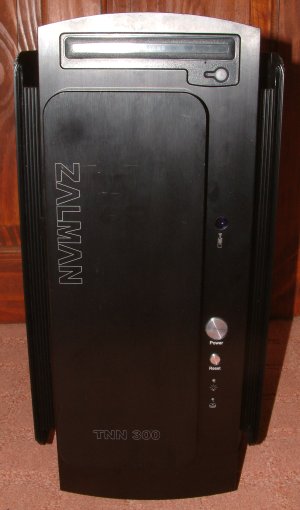External musings
So how is it possible to architect a mid-to-high-end system without the use of any fans? Surely hot components will overheat in a matter of minutes. The secret of fanless cooling lies with the chassis, Zalman's TNN (Totally No Noise) 300.
Taking its own, larger TNN 500 as a starting point, Zalman has created a smaller chassis in the TNN 300 that's purposely designed to act like a giant heatsink. Note the two large aluminium sections on either side? Their job is to ferry heat away from the case, much in the vein of modern radiators. Concentrating on the front for a moment, the black, minimalistic look is aesthetically pleasing. Quiet PC's involvement centres around equipping the basic chassis with the usual array of components that makes up a modern base unit, so it has to decide which CPU, graphics card, memory, optical drive, etc., to use. Elegant-looking power and reset buttons sit above activity LEDs, and only an infra-red receiver breaks up the exterior's smooth look. On the review sample, Quiet PC added in a matching Sony multi-format DVD ReWriter at the very top.

Turning the TNN 300 chassis to the right-hand side shows how Zalman has designed each side to act like a large heatsink. Extra surface area is generated by using a fins on each side, and, as mentioned internal heat is transferred to the external part of the chassis by using the tried-and-trusted heatpipe approach. The right-hand plate is responsible for pushing away the combined heat generated by the CPU and graphics card, whilst the left-hand side's main consideration lies with transferring heat away from the built-in, fanless PSU. A look from the top shows a large block that resides in between case and right-hand plate.
The TNN 300 chassis is considerably smaller than the TNN 500, small enough to accommodate micro-ATX-sized motherboards. Its lack of overall size makes totally passive running an even better achievement than on the TNN 500, and its base, unmodified weight of 12kg (chassis and internal PSU) is just light enough for it to be portable. Kitting it out with the requisite internal components pushes up the total base weight to around 15kg, though. Zalman amalgamates a pedestal so that you can easily turn the chassis around without having to lift it off the floor each and every time.

A look at the back shows more cooling in evidence. This time, though, the finned section is only a third of the size of the left and right hand duo. The lower portion of the rear is taken up by more mundane considerations such as the motherboard's I/O section and the graphics card/PCI slots directly underneath. Quiet PC, in building up this TNN 300 chassis, has also added an internal stereo digital amplifier whose outputs can be seen to the right of the I/O section.
Summarising what we've learned thus far, the petite TNN 300 chassis is designed to run the usual mix of components that make up a midrange PC without the use of any active cooling. It has been accomplished, from a look at the externals, by architecting the chassis as a single huge heatsink that convects heat away by using internal heatpipes allied to a large surface area. Let's now take a look inside.









